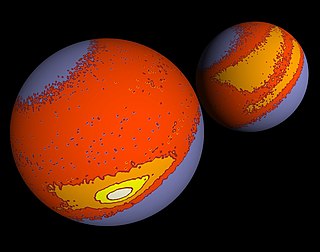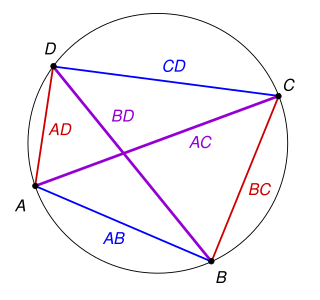This article relies largely or entirely on a single source .(May 2010) |
In probability theory and directional statistics, a circular uniform distribution is a probability distribution on the unit circle whose density is uniform for all angles.
This article relies largely or entirely on a single source .(May 2010) |
In probability theory and directional statistics, a circular uniform distribution is a probability distribution on the unit circle whose density is uniform for all angles.
The probability density function (pdf) of the circular uniform distribution, e.g. with , is:
We consider the circular variable with at base angle . In these terms, the circular moments of the circular uniform distribution are all zero, except for :
where is the Kronecker delta symbol.
Here the mean angle is undefined, and the length of the mean resultant is zero.


The sample mean of a set of N measurements drawn from a circular uniform distribution is defined as:
where the average sine and cosine are: [1]
and the average resultant length is:
and the mean angle is:
The sample mean for the circular uniform distribution will be concentrated about zero, becoming more concentrated as N increases. The distribution of the sample mean for the uniform distribution is given by: [2]
where consists of intervals of in the variables, subject to the constraint that and are constant, or, alternatively, that and are constant. The distribution of the angle is uniform
and the distribution of is given by: [2]
where is the Bessel function of order zero. There is no known general analytic solution for the above integral, and it is difficult to evaluate due to the large number of oscillations in the integrand. A 10,000 point Monte Carlo simulation of the distribution of the mean for N=3 is shown in the figure.
For certain special cases, the above integral can be evaluated:
For large N, the distribution of the mean can be determined from the central limit theorem for directional statistics. Since the angles are uniformly distributed, the individual sines and cosines of the angles will be distributed as:
where or . It follows that they will have zero mean and a variance of 1/2. By the central limit theorem, in the limit of large N, and , being the sum of a large number of i.i.d's, will be normally distributed with mean zero and variance . The mean resultant length , being the square root of the sum of squares of two normally distributed independent variables, will be Chi-distributed with two degrees of freedom (i.e.Rayleigh-distributed) and variance :
The differential information entropy of the uniform distribution is simply
where is any interval of length . This is the maximum entropy any circular distribution may have.

The Box–Muller transform, by George Edward Pelham Box and Mervin Edgar Muller, is a random number sampling method for generating pairs of independent, standard, normally distributed random numbers, given a source of uniformly distributed random numbers. The method was in fact first mentioned explicitly by Raymond E. A. C. Paley and Norbert Wiener in 1934.

The kinetic theory of gases is a simple, historically significant classical model of the thermodynamic behavior of gases, with which many principal concepts of thermodynamics were established. The model describes a gas as a large number of identical submicroscopic particles, all of which are in constant, rapid, random motion. Their size is assumed to be much smaller than the average distance between the particles. The particles undergo random elastic collisions between themselves and with the enclosing walls of the container. The basic version of the model describes the ideal gas, and considers no other interactions between the particles.

An ellipsoid is a surface that may be obtained from a sphere by deforming it by means of directional scalings, or more generally, of an affine transformation.
In mechanics and geometry, the 3D rotation group, often denoted SO(3), is the group of all rotations about the origin of three-dimensional Euclidean space under the operation of composition.

In mathematics, the beta function, also called the Euler integral of the first kind, is a special function that is closely related to the gamma function and to binomial coefficients. It is defined by the integral

In mathematics, the inverse trigonometric functions are the inverse functions of the trigonometric functions. Specifically, they are the inverses of the sine, cosine, tangent, cotangent, secant, and cosecant functions, and are used to obtain an angle from any of the angle's trigonometric ratios. Inverse trigonometric functions are widely used in engineering, navigation, physics, and geometry.
In mathematics, the Riemann–Siegel theta function is defined in terms of the gamma function as

Directional statistics is the subdiscipline of statistics that deals with directions, axes or rotations in Rn. More generally, directional statistics deals with observations on compact Riemannian manifolds including the Stiefel manifold.
In probability and statistics, a circular distribution or polar distribution is a probability distribution of a random variable whose values are angles, usually taken to be in the range [0, 2π). A circular distribution is often a continuous probability distribution, and hence has a probability density, but such distributions can also be discrete, in which case they are called circular lattice distributions. Circular distributions can be used even when the variables concerned are not explicitly angles: the main consideration is that there is not usually any real distinction between events occurring at the lower or upper end of the range, and the division of the range could notionally be made at any point.

In Euclidean geometry, Ptolemy's theorem is a relation between the four sides and two diagonals of a cyclic quadrilateral. The theorem is named after the Greek astronomer and mathematician Ptolemy. Ptolemy used the theorem as an aid to creating his table of chords, a trigonometric table that he applied to astronomy.

In probability theory and directional statistics, the von Mises distribution is a continuous probability distribution on the circle. It is a close approximation to the wrapped normal distribution, which is the circular analogue of the normal distribution. A freely diffusing angle on a circle is a wrapped normally distributed random variable with an unwrapped variance that grows linearly in time. On the other hand, the von Mises distribution is the stationary distribution of a drift and diffusion process on the circle in a harmonic potential, i.e. with a preferred orientation. The von Mises distribution is the maximum entropy distribution for circular data when the real and imaginary parts of the first circular moment are specified. The von Mises distribution is a special case of the von Mises–Fisher distribution on the N-dimensional sphere.
A ratio distribution is a probability distribution constructed as the distribution of the ratio of random variables having two other known distributions. Given two random variables X and Y, the distribution of the random variable Z that is formed as the ratio Z = X/Y is a ratio distribution.

In general relativity, a point mass deflects a light ray with impact parameter by an angle approximately equal to

In probability theory and directional statistics, a wrapped normal distribution is a wrapped probability distribution that results from the "wrapping" of the normal distribution around the unit circle. It finds application in the theory of Brownian motion and is a solution to the heat equation for periodic boundary conditions. It is closely approximated by the von Mises distribution, which, due to its mathematical simplicity and tractability, is the most commonly used distribution in directional statistics.
In probability theory and directional statistics, a wrapped probability distribution is a continuous probability distribution that describes data points that lie on a unit n-sphere. In one dimension, a wrapped distribution will consist of points on the unit circle. If φ is a random variate in the interval (-∞,∞) with probability density function p(φ), then z = e i φ will be a circular variable distributed according to the wrapped distribution pzw(z) and θ=arg(z) will be an angular variable in the interval (-π,π ] distributed according to the wrapped distribution pw.

In probability theory and directional statistics, a wrapped Cauchy distribution is a wrapped probability distribution that results from the "wrapping" of the Cauchy distribution around the unit circle. The Cauchy distribution is sometimes known as a Lorentzian distribution, and the wrapped Cauchy distribution may sometimes be referred to as a wrapped Lorentzian distribution.
In probability theory and directional statistics, a wrapped Lévy distribution is a wrapped probability distribution that results from the "wrapping" of the Lévy distribution around the unit circle.
In probability theory, the central limit theorem states conditions under which the average of a sufficiently large number of independent random variables, each with finite mean and variance, will be approximately normally distributed.

In probability theory and directional statistics, a wrapped exponential distribution is a wrapped probability distribution that results from the "wrapping" of the exponential distribution around the unit circle.
{{cite journal}}: Cite journal requires |journal= (help)